Chronic Pain
Ten Evidence-Based Strategies for Pain Relief
Tips and tools for treating chronic pain.
Posted February 26, 2020 Reviewed by Gary Drevitch

In this era of the opioid epidemic, it’s ever-more-important to find effective tools for treating chronic pain. These 10 expert, evidence-based strategies can offer some relief:
1. Take care of your emotional health just as well as you take care of your physical health. Neuroscience tells us that pain has cognitive and emotional components, and that our thoughts and feelings directly impact the pain we feel (Melzack, 2001). Need more evidence? Rather than having one single pain center in your brain, multiple parts of the brain contribute to the experience of pain. This includes your cerebral cortex (responsible for thoughts), limbic system (your brain’s emotion center!) and prefrontal cortex (which regulates attention) (Martucci & Mackey, 2018). Negative thoughts and emotions like stress, sadness and anger all amplify pain, while positive thoughts and emotions can turn pain volume down. Treating brain and body as if they’re disconnected is as false as it is dangerous. Brain and body are connected 100% of the time.
2. Learn more about pain. Learning about pain can actually lower pain volume, increase functionality, and reduce fear of movement (Louw et al, 2016). One gold nugget from the pain education literature is this: Pain, your body’s warning system, is not an accurate indicator of tissue damage, but is rather your brain’s best guesstimate as to how much danger your body is in and how much pain is required to protect it. Just because something “hurts” doesn’t necessarily mean your body is being “harmed.” Just like that car alarm outside your window honking and flashing when no one's robbing it, chronic pain is a malfunctioning false-alarm system futilely attempting to protect us – even in the absence of physical danger.
3. Seek treatments beyond pills and procedures. While medications and surgeries can be critical and life-saving, pain is never due exclusively to biological or anatomical issues. Rather, science tells us that pain is “biopsychosocial,” the combined result of biological factors (e.g. tissue damage, genetics, system dysfunction), psychological factors (e.g. emotions, thoughts, coping behaviors), and social factors (e.g. environmental context, access to care, social support) (Gatchel & Maddrey, 2004). Biomedical solutions that address only the “bio” component of pain therefore miss two-thirds of the pain problem! Other scientifically-supported interventions for pain management include Cognitive Behavioral Therapy (CBT), biofeedback, and Mindfulness-Based Stress Reduction (MBSR). Consider hiring a CBT therapist (it doesn’t mean you’re crazy, and it’s not all in your head!), try an MBSR group, and learn biofeedback – a powerful technique that connects the thoughts in your heads with the sensations in your body.
4. Start pacing. Just as you wouldn’t go outside and run a 26-mile-marathon tomorrow without training, you similarly wouldn’t resume all physical activities after months at home with pain. “Pacing” is a tried-and-true technique for slowly desensitizing brain and body, and gradually resuming your life (Antcliff et al, 2018). You can pace to return to any activity: soccer, sewing, work, or dance. While chronic pain tricks us into believing we should stay home and rest for months and years on end, reducing activity and avoiding movement only leads to a cycle of muscle atrophy, reduced fitness, an increasingly sensitive pain system, and more pain.
5. Practice sleep hygiene. The relationship between pain and sleep is cyclical: chronic pain notoriously makes it hard to sleep, and poor sleep exacerbates pain and symptoms. Moreover, poor sleep can affect all aspects of life, from cognitive functioning to physical performance to completion of tasks. Developing healthy sleep habits is therefore an important part of recovery. Harvard Medical School (2007) and pain experts around the world recommend avoiding: caffeine and sugar before bed, long naps during the day, sleeping in after a night of poor sleep, lounging in bed on screens, and other unhealthy habits to improve sleep.
6. Get to know your Pain Voice. Your Pain Voice is your inner bully – that negative, catastrophic voice in your head telling you that you’ll never get better, that the future is hopeless, that you can’t go out with friends or walk in the park. Get familiar with her: her demands, what she predicts, how she hurts you and holds you down. Name her, describe her, and notice that she’s not you – she’s just a manipulative, bossy voice in your head that wants to be in charge. Then talk back.
7. Schedule pleasurable activities. Plan to do at least one activity every day that gives you joy, be it fudge-making, cat-cuddling, or dancing in your living room. Research shows that pleasurable activities increase important pain-related brain chemicals such as serotonin, which can increase your mood to regulate pain (Villemure & Bushnell, 2009); dopamine, which increases feelings of pleasure and reward; and endorphins – your body’s natural pain killers! (Heinricher & Fields, 2013)
8. Get mindful. It’s easy to be skeptical of meditation or write it off as new-age-y fluff. But research shows that practicing mindfulness can change your brain to change your pain (Moseley & Flor, 2012). A regular mindfulness practice can strengthen your ability to sit with pain without battling it or pushing it away, change your focus, and regulate the negative thoughts and emotions that make pain worse (Garland et al, 2020).
9. Stay social and get support. Living a life with pain is hard, lonely, and full of challenges. Don’t go it alone. Talk to friends and family. Find an online chronic pain community. Join a book club, host a card game, volunteer at an animal shelter! Humans are genetically programmed to be social – having a tribe means protection from predators, food, shelter and support. So as tempting as it is, don’t isolate. Isolation leads to depression, anxiety, and more pain and health problems (Luo et al, 2012).
10. Don’t give up! Pain tries to rob you of hobbies, sports, friends, sex life, marriage, job, everything. It’s therefore understandably associated with depression, anxiety, even suicidality (Hassett et al, 2014). Individuals with chronic pain are at least twice as likely to report suicidal behaviors than those without (Racine, 2017). DON’T LET PAIN WIN. Hire a pain coach – aka, a pain psychologist, Cognitive Behavioral therapist (CBT), physical or occupational therapist, biofeedback practitioner, or other health provider – to help you conquer pain. There is hope. Knowledge is power, so the more you know, the stronger you grow.
References
Antcliff D, Keeley P, Campbell M, Woby S, Keenan AM, McGowan L. 2018. Activity pacing: moving beyond taking breaks and slowing down. Qual Life Res., 27(7):1933-1935.
Garland, E. L., Brintz, C. E., Hanley, A. W., Roseen, E. J., et al. (2020). Mind-Body Therapies for Opioid-Treated Pain: A Systematic Review and Meta-analysis. JAMA Internal Medicine, 180(1), 91-105.
Gatchel RJ & Maddrey AM. 2004. The Biopsychosocial Perspective of Pain. In: Raczynski J and Leviton L, eds. Healthcare Psychology Handbook. Vol II. American Psychological Association Press. Washington, DC.
Harvard Medical School. December 18, 2007. http://healthysleep.med.harvard.edu/healthy/getting/overcoming/tips
Hassett, A. L., Aquino, J. K., & Ilgen, M. A. (2014). The risk of suicide mortality in chronic pain patients. Current pain and headache reports, 18(8), 436.
Heinricher MM & Fields HL. (2013). Central nervous system mechanisms of pain modulation. Wall and Melzack's Textbook of Pain, Ed, 6, 129-142.
Louw A, Zimney K, Puentedura EJ, Diener I. 2016. The efficacy of pain neuroscience education on musculoskeletal pain: a systematic review of the literature. Physiotherapy theory and practice. 32(5):332-55.
Luo, Y., Hawkley, L. C., Waite, L. J., & Cacioppo, J. T. (2012). Loneliness, health, and mortality in old age: a national longitudinal study. Social Science & Medicine, 74(6), 907-914.
Martucci KT & Mackey SC. (2018). Neuroimaging of Pain: Human Evidence and Clinical Relevance of Central Nervous System Processes and Modulation. Anesthesiology: The Journal of the American Society of Anesthesiologists, 128(6): 1241-1254.
Melzack, R. (2001). Pain and the Neuromatrix in the Brain. Journal of Dental Education, 65(12), 1378-1382.
Moseley GL & Flor H. 2012. Targeting cortical representations in the treatment of chronic pain: a review. Neurorehabilitation and neural repair. 26(6):646-52.
Racine, M. (2018). Chronic pain and suicide risk: A comprehensive review. Progress in Neuro-Psychopharmacology and Biological Psychiatry, 87, 269-280.
Villemure, C. & Bushnell, M. C. (2009). Mood influences supraspinal pain processing separately from attention. Journal of Neuroscience, 29(3), 705-715.
Zoffness, R. (2019). The Chronic Pain and Illness Workbook for Teens. New Harbinger Press.




